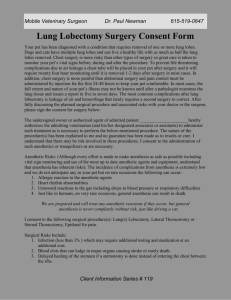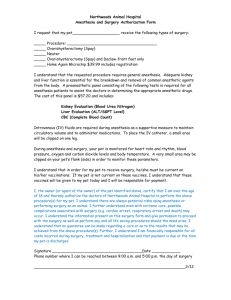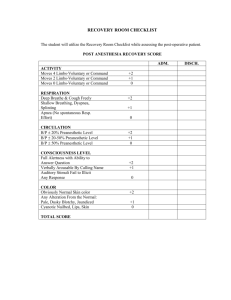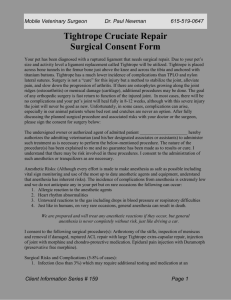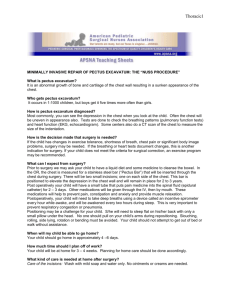Glucose Curve Procedure For Diabetics
advertisement
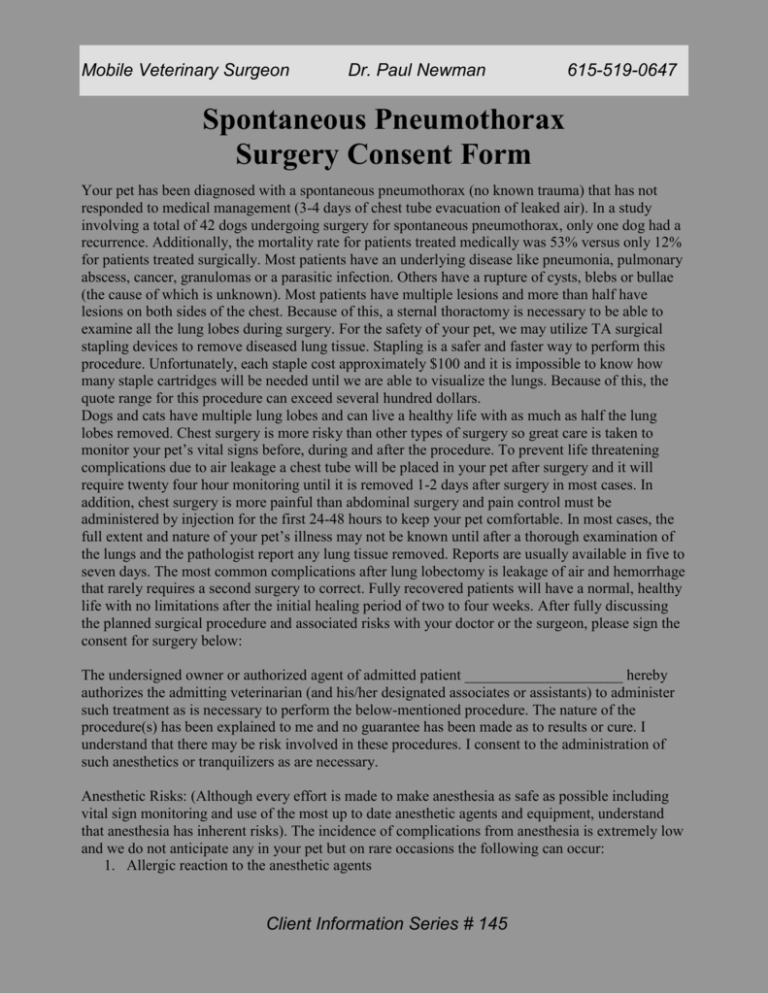
Mobile Veterinary Surgeon Dr. Paul Newman 615-519-0647 Spontaneous Pneumothorax Surgery Consent Form Your pet has been diagnosed with a spontaneous pneumothorax (no known trauma) that has not responded to medical management (3-4 days of chest tube evacuation of leaked air). In a study involving a total of 42 dogs undergoing surgery for spontaneous pneumothorax, only one dog had a recurrence. Additionally, the mortality rate for patients treated medically was 53% versus only 12% for patients treated surgically. Most patients have an underlying disease like pneumonia, pulmonary abscess, cancer, granulomas or a parasitic infection. Others have a rupture of cysts, blebs or bullae (the cause of which is unknown). Most patients have multiple lesions and more than half have lesions on both sides of the chest. Because of this, a sternal thoractomy is necessary to be able to examine all the lung lobes during surgery. For the safety of your pet, we may utilize TA surgical stapling devices to remove diseased lung tissue. Stapling is a safer and faster way to perform this procedure. Unfortunately, each staple cost approximately $100 and it is impossible to know how many staple cartridges will be needed until we are able to visualize the lungs. Because of this, the quote range for this procedure can exceed several hundred dollars. Dogs and cats have multiple lung lobes and can live a healthy life with as much as half the lung lobes removed. Chest surgery is more risky than other types of surgery so great care is taken to monitor your pet’s vital signs before, during and after the procedure. To prevent life threatening complications due to air leakage a chest tube will be placed in your pet after surgery and it will require twenty four hour monitoring until it is removed 1-2 days after surgery in most cases. In addition, chest surgery is more painful than abdominal surgery and pain control must be administered by injection for the first 24-48 hours to keep your pet comfortable. In most cases, the full extent and nature of your pet’s illness may not be known until after a thorough examination of the lungs and the pathologist report any lung tissue removed. Reports are usually available in five to seven days. The most common complications after lung lobectomy is leakage of air and hemorrhage that rarely requires a second surgery to correct. Fully recovered patients will have a normal, healthy life with no limitations after the initial healing period of two to four weeks. After fully discussing the planned surgical procedure and associated risks with your doctor or the surgeon, please sign the consent for surgery below: The undersigned owner or authorized agent of admitted patient _____________________ hereby authorizes the admitting veterinarian (and his/her designated associates or assistants) to administer such treatment as is necessary to perform the below-mentioned procedure. The nature of the procedure(s) has been explained to me and no guarantee has been made as to results or cure. I understand that there may be risk involved in these procedures. I consent to the administration of such anesthetics or tranquilizers as are necessary. Anesthetic Risks: (Although every effort is made to make anesthesia as safe as possible including vital sign monitoring and use of the most up to date anesthetic agents and equipment, understand that anesthesia has inherent risks). The incidence of complications from anesthesia is extremely low and we do not anticipate any in your pet but on rare occasions the following can occur: 1. Allergic reaction to the anesthetic agents Client Information Series # 145 Mobile Veterinary Surgeon Dr. Paul Newman 615-519-0647 2. Heart rhythm abnormalities 3. Untoward reactions to the gas including drops in blood pressure or respiratory difficulties 4. Just like in humans, on very rare occasions, general anesthesia can result in death. We are prepared and will treat any anesthetic reactions if they occur, but general anesthesia is never completely without risk, just like driving a car. I consent to the following surgical procedure(s): Lung(s) Lobectomy, Lateral Thoracotomy or Sternal Thoracotomy, Mechanical Pleurodesis, Epidural for pain, and Chest Tube Placement. Surgical Risks Include: 1. Infection (less than 3% ) which may require additional testing and medication at an additional cost. 2. Blood clots that can lodge in major organs causing stroke or rarely death. 3. Overall mortality for this procedure can approach 12% and typically occurs after most of the expenses have been incurred. 4. Delayed healing of the sternum if a sternotomy is done instead of entering the chest between the ribs. 5. Intra-operative or post-operative bleeding that can require blood transfusions. 6. Pneumothorax (leakage of air into the chest cavity) that requires additional surgery occurs in rare instances (1-2%). 7. Local tumor recurrence or metastases (spread to other organs) can occur if your pet has a tumor that is malignant. 8. Pleuritis (inflammation of the lining of the chest and lungs). 9. Lameness in the front leg on the side of the surgery can occur for 1-2 days due to cutting of the lattisimus dorsi muscle when entering the chest between the ribs. 10. Epidural complications are extremely rare but include transient (temporary) urinary retention, allergic reaction, itching at site of injection and transient rear leg weakness for one Although this list is extensive and includes some serious complications, most patients undergoing lung removal have very few complications and serious problems are very uncommon. ______________________________________________________________________________ Date Pet Owner/Agent Signature Phone I Can Be Reached At Today Client Information Series # 145
